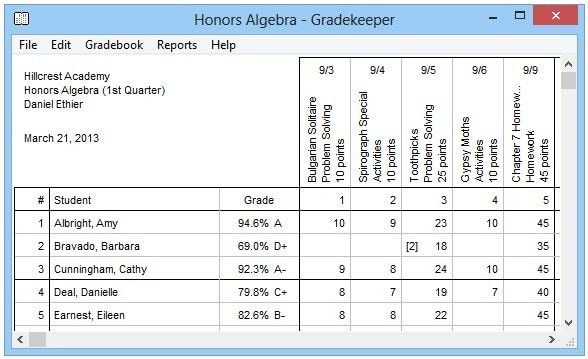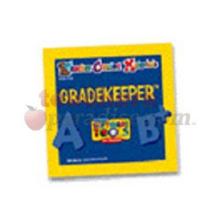

If tracking mastery is the goal, then a simpler program might do better. Navigation is not necessarily intuitive, and some of the more intricate features such as the extensive weighting options and multiple grading methods for each assignment may be more detailed and advanced than the typical K-12 teacher needs.
#Gradekeeper registration windows
The user interface has an old, Windows 3.1 look and feel. Gradebook2's rich features will come at a cost for those less experienced with technology, however.

Other options let teachers add comments for each assignment or student, work with a lesson planner, or access standards-based tracking, discipline and attendance records, and seating charts with student photographs. Offering the richest set of features of the products reviewed in this article, it includes extensive grade weighting options (including a formula builder that allows users to create any conceivable grading system) choice of numeric, decimal, letter, or symbol grades and the ability to accommodate bonus points, curves, and extra credit grades. Gradebook2, from the publisher of Pinnacle student information systems, is a good pick for more advanced users who appreciate a broad range of features and an open-ended option to create their own reports from scratch. In addition, can be set up to automatically e-mail updates to parents and students. With password-protected access, students and parents can view upcoming and past assignments, along with scores recorded to date. More than 20 reports are available to show class and individual student performance reports can be formatted and customized in a variety of ways. The ancillary features of such as reporting, import/export, and security are particularly strong. Extra grading features include the ability to drop the lowest score or to offer extra credit without having to create additional assignments. Assignments can be weighted based on percentage toward the overall grade or by category (e.g., homework, tests, quizzes). Unlike most other products that require one set grade scale for all classes, allows a customized grading setup for each class. The home page also includes a calendar that lists events and assignments for that day. For example, users can navigate from the home page to the main Score Page or jump directly to subsection pages such as Score by Assignment or Score by Student. The home page also provides convenient direct links to subsections of major features. The intuitive interface of includes a set of navigation tabs at the top of the screen that take users to pages for classes, categories, assignments, students, and scores. The wizard ends with the user at the grade book home page ready to enter data on classes, students, and assignments. Student and parent users can also send queries or comments to teachers via the program's integrated messaging system.Īlso Web-based, this product from Pearson's offers the same basic grade tracking function as ThinkWave Web Educator but expands on it with advanced reporting, import/export, and security features and a particularly intuitive interface.Ī New Class wizard guides the user through the setup process, prompting the teacher to select a grading scale, identify assignment types, and give each type a weight in calculating the final grade. The grade book itself is very basic, with relatively few options aside from allotting point values for assignments, indicating whether an assignment counts toward the final grade, and setting a conversion scale for letter grades.Ī ThinkWave Web Educator subscription fee includes a companion product, Grades Online, that allows parents and students to track progress in real time through secure access to assignments, grades, and class calendars over the Web.

The teacher home page lists upcoming assignments and active classes as well as the date and time of the last login a security feature designed to alert the user to hacking attempts or grade book tampering. Educators select a letter or numerical grading system, then use a navigation pane on the left side of the screen to add classes, students, assignments, lesson plans, and calendar items. Student records are stored by first name and last initial only, which protects student privacy but could potentially frustrate teachers whose students share similar names. Teachers can set up a grade book via a quick, four-step process in which they enter information about the school, personal contact information, a class name, term dates, and student names. This basic Web-based grade book application features grading, attendance, and lesson plan organization tools.


 0 kommentar(er)
0 kommentar(er)
